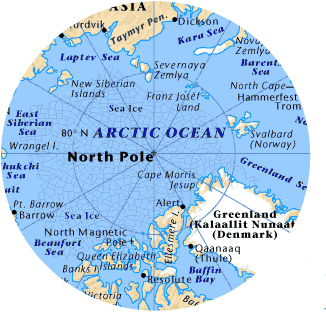Arctic Ocean Facts

The Arctic Ocean is the smallest and shallowest of the five oceanic divisions in the world, to be found in the Northern Hemisphere and mainly in the Arctic North Polar Region. Throughout the year, the ocean is largely covered with a sheet of sea ice due to very low temperatures. The Arctic Ocean is nearly completely surrounded by Eurasia and North America. Like Antarctica, the Arctic Ocean lacks the fabled history and beauty. It's actually a place for the most brutal and exposing adventure on earth. To know some more interesting, fun facts about the Arctic Ocean, read on.
Interesting and Fun Facts About Arctic Ocean
The Arctic Ocean is the smallest of the five oceans of the world. It's roughly 8% the size of the Pacific Ocean.
With total area of 14.056 million sq km, the Arctic Ocean includes Baffin Bay, Barents Sea, Beaufort Sea, Chukchi Sea, East Siberian Sea, Greenland Sea, Hudson Bay, Hudson Strait, Kara Sea, Laptev Sea, Northwest Passage, and other tributary water bodies.
The Arctic Ocean has a coastline of 45,389 km and has depth of 4,665 m (from basin).
The Ocean boasts several important ports and harbors like Churchill (Canada), Murmansk (Russia) and Prudhoe Bay (US).
The economic activity from the ocean is limited to the utilization of natural resources, including petroleum, natural gas, fish, and seals.
The Northwest Passage (North America) and Northern Sea Route (Eurasia) are important seasonal waterways of the Arctic Ocean.
The Arctic Ocean's cold sheet of floating ice is quarters to seals, polar bears and arctic fox.
The floating ice is around 16 million sq. km, which shrinks to 9 million sq. km. in summers. When the ice shrinks, open water leads expose the black water.
The Arctic Ocean's ice sheet is four times as large as the state of Texas.
More fish live along the edges of the Arctic Ocean than anywhere else on the Earth.
Its average winter temperature is minus 30 degrees Fahrenheit. However, during summers, the temperature can rise up to plus 50 degrees Fahrenheit.
The Arctic is the only place on the Earth where polar bears live. It receives roughly 8 inches of rain every year.
Most of the Arctic Ocean is permanently covered with a vast floating raft of sea ice.
Temperatures are low all year round, averaging -30°C in winter and sometimes dropping to -70°C.
During the long winters, which last more than four months, the Sun never rises above the horizon.
The Arctic gets its name from arctos, the Greek word for ‘bear, because the Great Bear constellation is above the North Pole.
There are three kinds of sea ice in the Arctic: polar ice, pack ice and fast ice.
Polar ice is the raft of ice that never melts through.
Polar ice may be as thin as 2 m in places in summer, but in winter it is up to 50 m thick.
Pack ice forms around the edge of the polar ice and only freezes completely in winter.
The ocean swell breaks and crushes the pack ice into chunky ice blocks and fantastic ice sculptures.
Fast ice forms in winter between pack ice and the land around the Arctic Ocean. It gets its name because it is held fast to the shore. It cannot move up and down with the ocean as the pack ice does.
The seal is one of the few creatures that can survive the bitter cold of the Arcticwinter.
Interesting and Fun Facts About Arctic Ocean
The Arctic Ocean is the smallest of the five oceans of the world. It's roughly 8% the size of the Pacific Ocean.
With total area of 14.056 million sq km, the Arctic Ocean includes Baffin Bay, Barents Sea, Beaufort Sea, Chukchi Sea, East Siberian Sea, Greenland Sea, Hudson Bay, Hudson Strait, Kara Sea, Laptev Sea, Northwest Passage, and other tributary water bodies.
The Arctic Ocean has a coastline of 45,389 km and has depth of 4,665 m (from basin).
The Ocean boasts several important ports and harbors like Churchill (Canada), Murmansk (Russia) and Prudhoe Bay (US).
The economic activity from the ocean is limited to the utilization of natural resources, including petroleum, natural gas, fish, and seals.
The Northwest Passage (North America) and Northern Sea Route (Eurasia) are important seasonal waterways of the Arctic Ocean.
The Arctic Ocean's cold sheet of floating ice is quarters to seals, polar bears and arctic fox.
The floating ice is around 16 million sq. km, which shrinks to 9 million sq. km. in summers. When the ice shrinks, open water leads expose the black water.
The Arctic Ocean's ice sheet is four times as large as the state of Texas.
More fish live along the edges of the Arctic Ocean than anywhere else on the Earth.
Its average winter temperature is minus 30 degrees Fahrenheit. However, during summers, the temperature can rise up to plus 50 degrees Fahrenheit.
The Arctic is the only place on the Earth where polar bears live. It receives roughly 8 inches of rain every year.
Most of the Arctic Ocean is permanently covered with a vast floating raft of sea ice.
Temperatures are low all year round, averaging -30°C in winter and sometimes dropping to -70°C.
During the long winters, which last more than four months, the Sun never rises above the horizon.
The Arctic gets its name from arctos, the Greek word for ‘bear, because the Great Bear constellation is above the North Pole.
There are three kinds of sea ice in the Arctic: polar ice, pack ice and fast ice.
Polar ice is the raft of ice that never melts through.
Polar ice may be as thin as 2 m in places in summer, but in winter it is up to 50 m thick.
Pack ice forms around the edge of the polar ice and only freezes completely in winter.
The ocean swell breaks and crushes the pack ice into chunky ice blocks and fantastic ice sculptures.
Fast ice forms in winter between pack ice and the land around the Arctic Ocean. It gets its name because it is held fast to the shore. It cannot move up and down with the ocean as the pack ice does.
The seal is one of the few creatures that can survive the bitter cold of the Arcticwinter.

0 comments:
Post a Comment